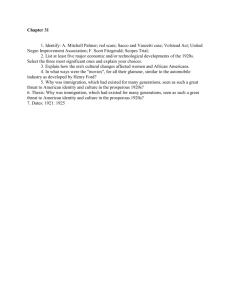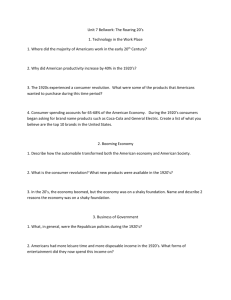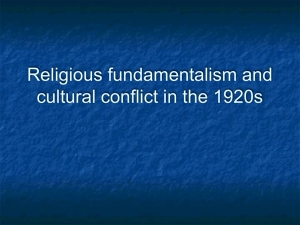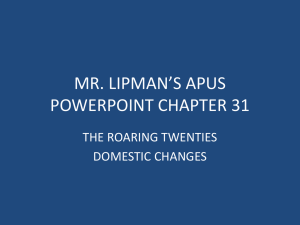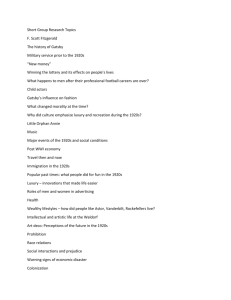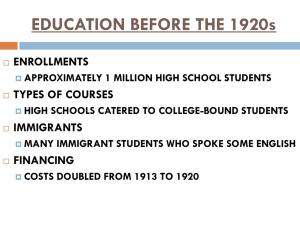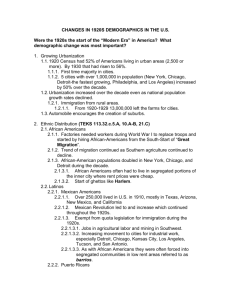1920s and Hoover Notes
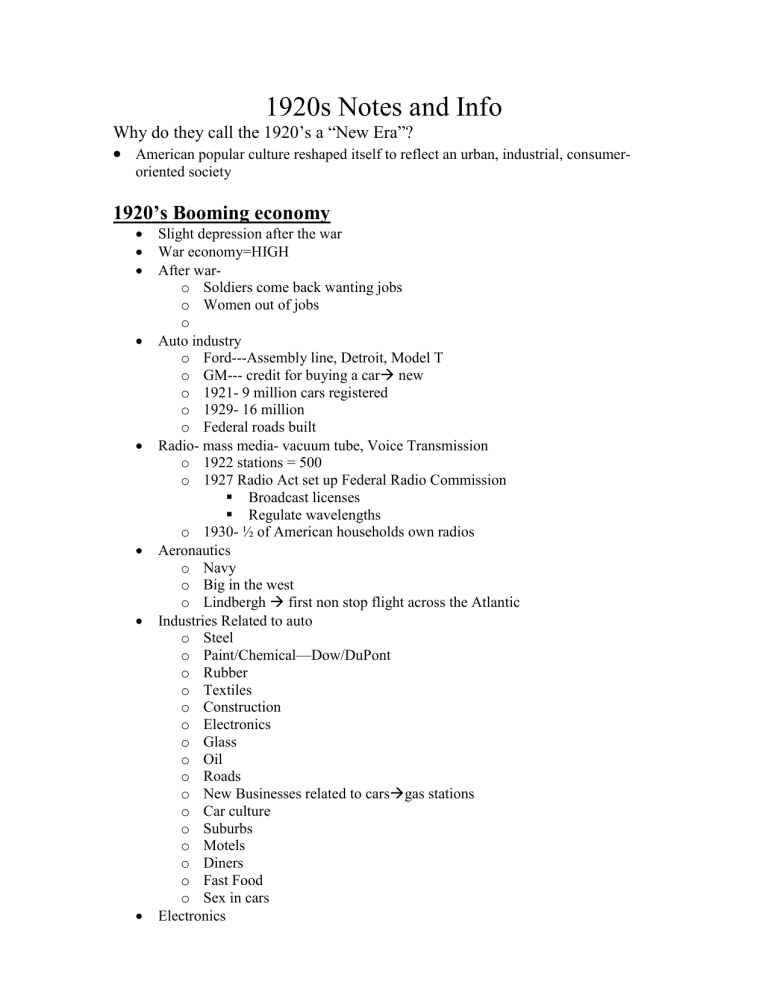
1920s Notes and Info
Why do they call the 1920’s a “New Era”?
American popular culture reshaped itself to reflect an urban, industrial, consumeroriented society
1920’s Booming economy
Slight depression after the war
War economy=HIGH
After war- o Soldiers come back wanting jobs o Women out of jobs o
Auto industry o Ford---Assembly line, Detroit, Model T o GM--- credit for buying a car
new o 1921- 9 million cars registered o 1929- 16 million o Federal roads built
Radio- mass media- vacuum tube, Voice Transmission o 1922 stations = 500 o 1927 Radio Act set up Federal Radio Commission
Broadcast licenses
Regulate wavelengths o 1930- ½ of American households own radios
Aeronautics o Navy o Big in the west o Lindbergh
first non stop flight across the Atlantic
Industries Related to auto o Steel o Paint/Chemical—Dow/DuPont o Rubber o Textiles o Construction o Electronics o Glass o Oil o Roads o New Businesses related to cars
gas stations o Car culture o Suburbs o Motels o Diners o Fast Food o Sex in cars
Electronics
o Irons o Fans o Toasters o Vacuums o Stove o Washing machine o Sewing o Fridge o General Electric/Westinghouse o 70% of country is “electrified” o EDISON = father of electricity
Edison Electric
invented electric chair
DEBT
installment plans
Republican- pro-business policies o Wealth Concentrated upward o Mellon- Secretary of the Treasury= lowered taxes for rich, 1/3 less than
1920 o Weak anti-trust enforcement o 1/3 of country lived in poverty less than $2000 year o 1/5 of country less than $1000 year
Labor Suffers a decline o Union membership 5 million in 1919 o 3.6 million 1923
Welfare Capitalism
o Anti-union idea o Employers
try to eliminate need for unions
Paternalistic programs to help workers
Mechanisms for workers to address grievances
Republican support
don’t like unions o Companies sponsor programs for workers
Life insurance
Profit sharing
Sports teams
Company union
Agribusiness
o Farmers o Large Business take over farms
Farm prices go down
Drive ppl out of business o Over-production of after war cause prices to fall o Continued Rural to Urban Migration- 6 million
Foreign Policy
Myth of “Isolationism’ o U.S. Isolationism = just focus on America
No League of Nations
o EXCEPTION:
The Dawes Plan
German reparations for WWI
Private bankers help invested in Germany
Washington – Arms Limitation Conference
limit navy warships
Reinforce agreement over Pacific possession
Japan
French
British
United States
Open Door policy
Pan- American treaty
use peaceful means to settle disputes
to remove American imperialism
Kellogg-Briad Pact
outlaws war
No enforcement o Internationalism = work with other nations
Wilson, Harding, Coolidge,
Hoover, Lodge, Washington
ARE WE ISOLATED IN THIS PERIOD??
Mass Media
Movies- o Charlie Chaplin - star o Rudolph Valentino- star o 1927 Sound comes to the movies o 1928 Mickey Mouse o 1930 100 million Americans go to movies each week
Time Magazine
National Sports o Babe Ruth - 60 Homeruns
Charles Lindbergh o Spirit of St. Louis o May 20, 1927- First non-stop flight across the Atlantic
Consumerism
o Advertising Emerges o Presentation of products to the public in Effort to stimulate Demand o Brand Loyalty created o Public Relations industry develops
Eugenics Movement
o New Science of genetics o Idea that characteristics can be passed on from one person to their offspring o Feeblemindedness = mental retardation o Sexual Delinquencies o Leads to sterilization o The desire to eliminate unwanted characteristics o 24 States have sterilization laws o 20,000 people sterilized by 1930 o Supreme Court Supported Sterilization in Buck Vs. Bell o Justice Oliver Wendell Holmes o “It is better for al the world, if instead of waiting to execute degenerate offspring. For crime, or to let them starve for their imbecility, Society can prevent those who are manifestly unfit from continuing their kind.”
“Jazz Age”
o Phrase Coined by F. Scott Fitzgerald o Music brought North by Blacks from the South o Fast paced creativity o Improvisation, innovation o Sexuality
Literature of the 1920s
o “Lost Generation”
o Term used to describe the bohemian, disillusioned, American expatriates living in Paris after WWI o Lost Generation is a phrase made popular by American author Ernest
Hemingway in his first published novel The Sun Also Rises.
Often it is used to refer to a group of American literary notables who lived in Paris and other parts of Europe, some after military service in the First World
War. o Figures identified with the "Lost Generation" include authors and poets o F. Scott Fitzgerald, Hemingway, Ezra Pound, Sherwood Anderson,
Waldo Peirce, and John Dos Passos . o F. Scott Fitzgerald o The Great Gatsby – story set in 1920s critical of materialism and corruption o This Side of Paradise - Story set in 1920s o Hemmingway- o The Sun Also Rises- Story of the “Lost Generation” o A Farwell To Arms- story of the love in World War I
The Harlem Renaissance
o African Americans moved North during the War= the Great Migration o Continues in the 1920s- 1 Million Af Am move North o By
1930 40% of Nation’s Blacks live in North (5million)
(12 million total) o Cultural movement in 1920s New York City, African American community, Renews and celebrates Black Culture o Jazz Music- Duke Ellington, Louis Armstrong… o Literature- Langston Hughes, Zora Neal-Hurston
Black Nationalism
o Marcus Garvey - wanted - racial pride and separateness for African Americans o Founded Universal Negro Improvement Association (UNIA) o Said be proud of your race o Back to Africa Movement o 80-100,000 members o Mail Fraud and laer Deported later o Recall NAACP- W.E.B. DuBois (didn’t like Garvey’s message)
Women in the 1920s
o 19 th Amendment - Women’s right to vote takes affect o Alice Paul - Suffragette, supports an Equal Rights Ammednment for women, not passed o Forms a National Women’s Party , to eliminate discrimination in law of women o “Men and women shall have equal rights throughout the United States.” o Regarding laws, contracts, personal property, Equal Guardianship, Serve on
Juries, and to Jobs (not successful) o Flappers o Chic, young women of the 1920s o Hip, cool, en vogue o Different behavior, appearance, dress
Bobbed hair
Short skirts
Thin shape
Makeup
Smoking
Drinking
Sexual liberation
Provocative dancing o Really represents GENERATIONAL conflict and change o Margaret Sanger - feminist activist
Advocated birth control
American Birth Control League
Planned Parent Hood o Divorce Rates rise in the 1920s o Women Enter the workforce more o Amelia Earhart the female Lindbergh o Women in college o Women in professions- increases- more doctors lawyers o Women enter Nurturing fields
Teachers, librarians, social workers
Discriminated against
Paid less than men
Promoted less than men o Women and Education
College Graduates- doubled
Women with Doctorates increases
Tensions in American Society
o Nativism
WASPs resented Catholics, Jews, Speakeasies, Flappers,
Anti-Immigrant
Anti-Alcohol
Anti-Minorities
Anti-Teaching of Evolution o The Ku Klux Klan revives (white robes represented purity)
Becomes a main-stream movement- of American Pride and values
5000 members in 1920
100,000 member in 1922
4.5 Million members in 1924
Wanted pure Americanism
Anti- Jew
Anti-Catholic
Anti-Foreign influence
Popular in South, Midwest and Small towns and cities o Immigration Restrictions
Opposition to immigration continues and grows
Organized Labor is against free immigration
Too many immigrants = low wages
Red Scare - helped shape anti-Immigrant attitudes
Racism also
Eugenicist s also said- Southern and Eastern European immigrants were inferior
National Origins Act 1924
Placed permanent restrictions on Immigration
“The primary reason for the restriction of the Alien stream…is the necessity for purifying and keeping pure the blood of
America.”
Reduced the Quota for Admission to 2% of Americans of o Red Scare that National Origin in1890
No limits on Latin America
Bans immigration from Asia
Hoover and the Depression
How does Hoover respond to the Depression?
How does this reflect his philosophy regarding governments’ role in the economy? o Republican views o Volunteerism—no gov. intervention o No deficit financing o Bank relief o Opposed to unemployment insurance o Bonus army
Terms to add to list
“Dust Bowl”
“Okies”
Woody Guthrie
Buying Stocks on Margin
Bank Failures
Steinbeck—The Grapes of Wrath

